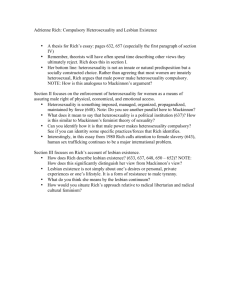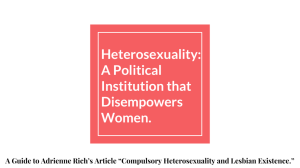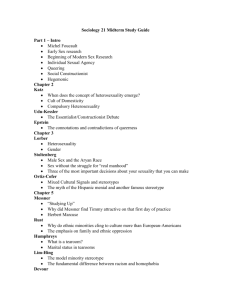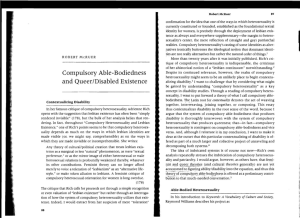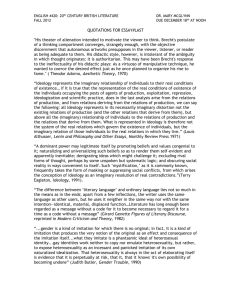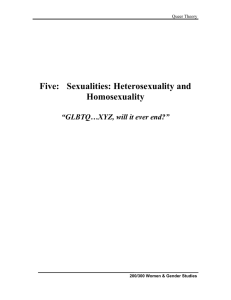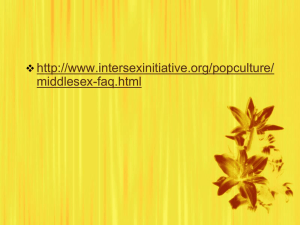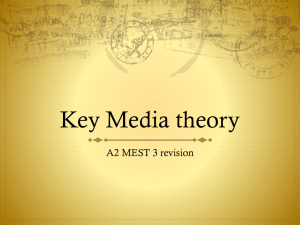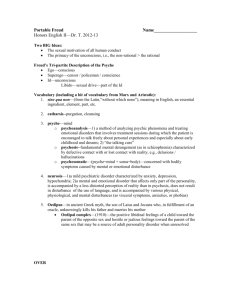Critical Heterosexualities - American Sociological Association
advertisement
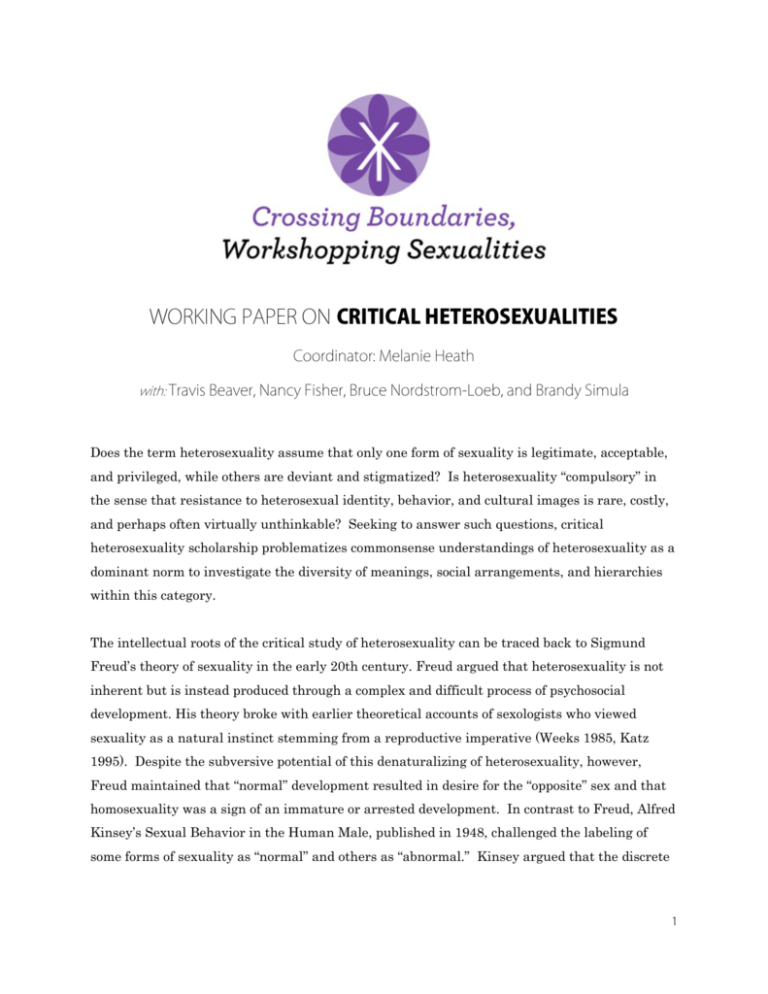
WORKING PAPER ON CRITICAL HETEROSEXUALITIES Coordinator: Melanie Heath with: Travis Beaver, Nancy Fisher, Bruce Nordstrom-Loeb, and Brandy Simula Does the term heterosexuality assume that only one form of sexuality is legitimate, acceptable, and privileged, while others are deviant and stigmatized? Is heterosexuality “compulsory” in the sense that resistance to heterosexual identity, behavior, and cultural images is rare, costly, and perhaps often virtually unthinkable? Seeking to answer such questions, critical heterosexuality scholarship problematizes commonsense understandings of heterosexuality as a dominant norm to investigate the diversity of meanings, social arrangements, and hierarchies within this category. The intellectual roots of the critical study of heterosexuality can be traced back to Sigmund Freud’s theory of sexuality in the early 20th century. Freud argued that heterosexuality is not inherent but is instead produced through a complex and difficult process of psychosocial development. His theory broke with earlier theoretical accounts of sexologists who viewed sexuality as a natural instinct stemming from a reproductive imperative (Weeks 1985, Katz 1995). Despite the subversive potential of this denaturalizing of heterosexuality, however, Freud maintained that “normal” development resulted in desire for the “opposite” sex and that homosexuality was a sign of an immature or arrested development. In contrast to Freud, Alfred Kinsey’s Sexual Behavior in the Human Male, published in 1948, challenged the labeling of some forms of sexuality as “normal” and others as “abnormal.” Kinsey argued that the discrete 1 categories of “heterosexual” and “homosexual” are a social construction, marking a continuum between the poles of exclusive heterosexuality and exclusive homosexuality. While Kinsey’s work contested the naturalness and even the reality of exclusive heterosexuality, his research lacked a critique of heterosexuality as an institution. This more recent emphasis arose out of the gay liberation, radical feminist, and lesbian feminist movements in the 1970s prior to its emergence in the academy (Katz 1995). Within the academy, Gayle Rubin’s (1975) essay “The Traffic in Women: Notes on the ‘Political Economy’ of Sex” argued that the social division of labor by sex produced gender differences, made particular forms of heterosexuality “obligatory,” and resulted in women’s oppression. Monica Wittig’s (1992) essays in the mid-1970s also provided early examples of an explicit naming of heterosexuality as an institution and a “political regime” that produces the distinction between the sexes while leading to men’s dominance over and exploitation of women. Similarly, Adrienne Rich’s (1980) classic essay “Compulsory Heterosexuality and Lesbian Existence” argued that heterosexuality must be studied as a political institution based on the coercion of women into exploitative relationships that benefit men physically, economically, and emotionally, while at the same time prevents women from developing alliances and intimate relationships with one another. Taken together, this early work exemplifies key aspects of the critical study of heterosexuality: first, that heterosexuality is an institution that requires explicit study and naming and second, that unequal power relations between men and women are embedded within and produced by this institution. Studying heterosexuality as a social institution means that heterosexuality operates as a highly structured social arrangement; it is an organized set of social practices that guide the behavior of large numbers of people through norms, rules and rituals (Ingraham 2002). Because institutionalized heterosexuality is highly norm- and rule-bound, it must be learned through socialization. Mothers talk to their children in ways that romanticize opposite-sex relationships, while making same-sex relationships invisible (Martin 2009), while fathers raise their sons to perform masculinity in ways that are "as heterosexual as possible" (Solebello and Elliott 2011). This illustrates how heterosexuality is institutionalized in ways that reflect distinct power relations between men and women, and between heterosexuals and homosexuals (and any nonstraight identities that fall between). Moreover, institutionalized heterosexuality creates hierarchies amongst heterosexuals themselves, according to those who fall closest to a coupled, monogamous ideal (Seidman 2005). 2 There is a close conceptual relationship between institutionalized heterosexuality and heteronormativity. Heteronormativity serves as the organizing principle of institutionalized heterosexuality. Also known as "normative heterosexuality," this concept captures the privileging of heterosexuality throughout social life. Heterosexuality is often regarded as naturally occurring, normal and not in need of explanation. For example, many bureaucratic forms ask citizens to supply information about their marital status, even when such information - married, divorced, widowed, never married - is not relevant or particularly useful (Ingraham 2002). Yet these mundane social practices communicate that heterosexual coupling (and coupling generally) is the norm and that all other relationships either do not count (a gay couple of 20 years is simply two individuals who are classified as "never married") or that they garner lesser social status and respect. While the two concepts are closely related, institutionalized heterosexuality is not reducible to heteronormativity since not all of the ways that institutional regulation takes place can be explained in terms of normative heterosexuality (Jackson 2006a). There are multiple sites where institutionalized heterosexuality is visible, including the family (Martin 2009; Solebello and Elliott 2011); popular culture (Ingraham 2008); schools (Myers and Raymond 2010) and the state, which is particularly significant. In this regard, critical heterosexual scholars examine how the reproduction of normative heterosexuality structures law and social life. In particular, social policy is seen as an important site where 'truths' about sexuality are contested, challenged, and transformed. This scholarship questions the universal acceptance in social policy and law of sexuality as heterosexual, 'normal', 'natural' and fixed, an assumption that reinforces heterosexual norms and relations. It further critiques mainstream work on the family which often ignores non-nuclear family forms and fails to take into account service and welfare provision based on non-universalistic family forms. Important scholarship in this area includes Ingraham (1999), who theorizes “the wedding industrial complex” as a structure that sits at the nexus of associations among weddings, marriage, the state, religion, media, and popular culture. Theorizing from a critical heterosexuality perspective, Heath (2009, 2012) studied marriage promotion politics in the United States as a case where federal and state actors enact policies to reinstate the heterosexual, nuclear family in American culture. Canaday (2009) offers another example of scholarship in considering the relationship of the state to producing homosexual identities. She sheds light on the importance of state-building processes, specifically arguing that the relatively 3 late growth of the American state, coinciding with the emergence of new homosexual identities, explains why “the American bureaucracy was so much more homophobic than its [longer established] corollaries in western Europe” (p. 258). This scholarship attests to the ways that sexuality is intimately connected with state practices and social policy. Critical heterosexuality studies emphasize that heterosexuality is not a monolithic category and seeks to examine the diversity of practices and identities associated with it (Hockey, et al. 2007; Richardson 1996a). Scholarship that investigates the diversity of heterosexual identities and practices often intersects with studies of the diversity of gender identifications and performances (Ingraham 1994; Jackson 1999; Jackson 2006a; Jackson 2006b; Richardson 1996b; Wiegman 2006). While critical studies of heterosexuality, rooted in feminist theory, have long examined the ways that women who identify as heterosexual experience heterosexuality, more recent work has focused on the diversity of men’s heterosexual identification and practices. Dean (2007), for example, examines the diversity of ways that straight-identified men perform gender and sexuality and finds that for some men, explicitly rejecting homophobia and the conflation of gender and sexuality is a part of their heterosexual identities. Scholars working within critical heterosexuality studies have also examined the possibilities of constructing and inhabiting non-oppressive heterosexualities (Hollway 1996; Jackson 1996a). Some have argued that anti-heteronormative identities, including critical heterosexual identities, can be understood as queer identities (Smith 2000) or that individuals who occupy those positions might be understood as “straight queers” (Thomas 2000). In so doing, this scholarship critiques and expands both “queer” and “heterosexual” as conceptual tools and identity categories, pointing to the diversity of meanings within as well as across those categories. REFERENCES Canaday, Margot. 2009. The Straight State: Sexuality and Citizenship in Twentieth-Century America. Princeton: Princeton University Press. Dean, James. 2007. Straight men. In Introducing the New Sexuality Studies, edited by S. Seidman, N. Fischer and C. Meeks. New York: Routledge. Heath, Melanie. 2009. State of our Unions: Marriage Promotion and the Contested Power of Heterosexuality.” Gender & Society 23 (1): 27-48. -------. 2012. One Marriage Under God: The Campaign to Promote Marriage in America. New York: New York University Press. Hockey, Jenny, Angela Meah, and Victoria Robinson. 2007. Mundane Heterosexualities: From Theory to Practices. New York: Palgrave Macmillan. 4 Hollway, Wendy. 1996. “Recognition and Heterosexual Desire.” In Theorising Heterosexuality, edited by D. Richardson. Bristol, PA: Open University Press. Ingraham, Chrys. 1994. “The Heterosexual Imaginary: Feminist Sociology and Theories of Gender.” Sociological Theory 12: 203-19. -------. 2002. "Heterosexuality: It's Just Not Natural!" in S. Seidman and D. Richardson, eds. Handbook of Gay and Lesbian Studies, Sage Publications. -------. 2008. 2nd ed. White Weddings: Romancing Heterosexuality in Popular Culture. New York: Routledge. Jackson, Stevi. 1996. “Heterosexuality and Feminist Theory.” In Theorising Heterosexuality: Telling it Straight, edited by D. Richardson. Buckingham: Open University. -------. 1999. Heterosexuality in Question. London: Sage. -------. 2006a. "Interchanges: Gender, Sexuality and Heterosexuality: The Complexity (and Limits) of Heteronormativity." Feminist Theory, 2006 7: 105-121. -------. 2006b. “Heterosexuality, Sexuality, and Gender: Re-thinking the Intersections.” In Intersections Between Feminist and Queer Theory, edited by D. Richardson, J. McLaughlin and M. E. Casey. Basingstoke, England: Palgrave Macmillan. Katz, Jonathan Ned. 1995. The Invention of Heterosexuality. New York: Plume. Martin, Karin. 2009. "Normalizing Heterosexuality: Mothers' Assumptions, Talk, and Strategies with Young Children." American Sociological Review, 74:2: 190-207. Myers, Kristin and Laura Raymond. 2010. "Elementary School Girls and Heteronormativity: The Girl Project. Gender & Society 24: 167-188. Rich, Adrienne. 1980. “Compulsory Heterosexuality and Lesbian Existence.” Signs 5(4):631-60. Richardson, Diane. 1996a. “Heterosexuality and Social Theory.” In Theorising Heterosexuality, edited by D. Richardson. London: Open University Press. Richardson, Diane, ed. 1996b. Theorising Heterosexuality. Philadelphia: Open University Press. Rubin, Gayle. 1975. “The Traffic in Women: Notes on the ‘Political Economy’ of Sex.” Pp. 157-210 in Toward an Anthropology of Women, edited by R. Reiter. New York: Monthly Review Press. Seidman, Steven. 2005. "From the Polluted Homosexual to the Normal Gay: Changing Patterns of Sexual Regulation in America" in C. Ingraham, ed. Thinking Straight: New Work in Critical Heterosexuality Studies, pp. 39-62. New York: Routledge. Smith, Clyde. 2000. “How I Became a Queer Heterosexual.” In Straight with a Twist: Queer Theory and the Subject of Heterosexuality, edited by C. Thomas. Chicago: University of Illinois Press. Solebello, Nicholas and Sinikka Elliott. 2011. "'We Want Them to Be as Heterosexual as Possible' Fathers Talk about Their Teen Children's Sexuality." Gender & Society 25:3:293-315. Thomas, Calvin. 2000. ed. Straight with a Twist: Queer Theory and the Subject of Heterosexuality. Chicago: University of Illinois Press. Weeks, Jeffrey. 1985. Sexuality and Its Discontents: Meanings, Myths, and Modern Sexualities. New York: Routledge. Wiegman, Robyn. 2006. “Heteronormativity and the Desire for Gender.” Feminist Theory 7: 89-103. Wittig, Monica. 1992. The Straight Mind and Other Essays. Boston: Beacon Press. 5
